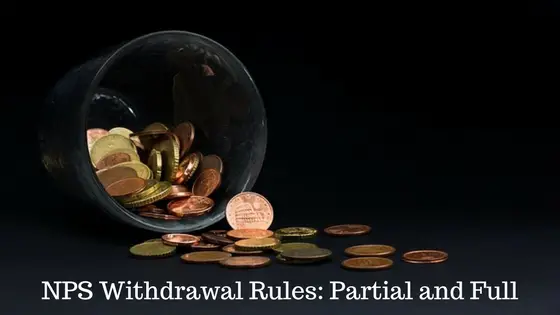National Pension Scheme (NPS) is a financial product you can use for your retirement planning. It is not much popular among the investors as it is less liquid and partially taxed during maturity. I have already expressed my views in a separate post which can build your perspective whether should you invest in NPS or not. However, in this post, i am going to write about the NPS withdrawal rules, how you can exit from NPS or partially withdraw from NPS.
NPS Withdrawal Rules 2018
Rules for Exiting NPS:
You can exit from NPS at the age of 60 years. If your employer indicates the retirement age as 58 years, you can exit from NPS at that age. At the time of retirement, 40% of the accumulated corpus is to be invested into an annuity plan for the monthly pension, 60% of the total corpus you can take as a lump sum. But out of this 60%, only 40% of the total corpus is tax-free and remaining 20% of the total corpus is taxable. Now, if you convert this 20% corpus to purchase the annuity with existing 40% corpus that will be tax-free.
At the time of retirement, 40% of the accumulated corpus is to be invested into an annuity plan for the monthly pension, 60% of the total corpus you can take as a lump sum. But out of this 60%, only 40% of the total corpus is tax-free and remaining 20% of the total corpus is taxable. Now, if you convert this 20% corpus to purchase the annuity with existing 40% corpus that will be tax-free.
You can wait up to 3 years for the purchase of an annuity from superannuation for a better rate. You can also defer the lump sum withdrawal up to 70 years age to lower the tax burden as the tax limit grows with the age.
If the accumulated corpus s less than Rs 2 lakhs you can withdraw the full amount. It is not mandatory to purchase an annuity.
Early Exit Rules for Government Sector Employees:
If a government employee voluntarily tale the retirement before the superannuating age, he or she has to take the annuity with the 80% of the accumulated corpus. 20% of the total corpus can be withdrawn as lump sum. There will be no option to defer the exercise of buying the annuity or lump sum withdrawal. If the accumulated corpus is less than Rs 1 lakh it can be withdrawn in full amount.
In the case of death of government employee, the legal heirs or nominee can withdraw 40% amount as a lump sum, 60% of the amount to purchase an annuity for the monthly pension. If the accumulated wealth is less than Rs 2 lakhs, there is no need to purchase the annuity for the family members.
If the NPS subscriber dies after retirement and before purchasing of annuity, the nominee or legal heirs should have to purchase the annuity and lump sum withdrawal as early as possible.
Early Exit Rules for Private Sector Employees or other Citizens:
A private sector employee is allowed to exit from NPS only after 3 years of successful subscription.
In case of retirement from the service before the age of 60 or attaining superannuation, 80% of the total corpus is to be used for purchasing the annuity. Balance 20% can be withdrawn as lump sum. There will be no option to defer the purchase of an annuity as well as lump sum withdrawal. This rule is same as government employees. If the total corpus is less than Rs 2 lakhs, it can be withdrawn as lump sum.
In case of death of the NPS subscriber before the age of 60 or attaining superannuation, the entire corpus can be withdrawn as a lump sum by the nominee or legal heirs. Purchase of annuity plan is not mandatory in this case.
Partial Withdrawal Rules:
Like the EPF and PPF, you can also partially withdraw from NPS. You can withdraw from NPS for the following reasons:
- Child’s higher education. It also applies to the legally adopted child.
- Marriage of children including the legally adopted child.
- Treatment of Critical Illness of self, spouse, children or dependent parents
- Purchase or construction of the first house (not applicable if the subscriber is already a sole or joint owner of a residential house or flat). If you have the only ancestral property you can take the benefit.
- For treatment of illness of the subscriber, spouse, children (Including legally adopted child) and dependent parents. The following diseases are applicable for the withdrawal as specified in the PFRDA notice.
-
- Cancer
- Kidney Failure (End Stage Renal Failure)
- Primary Pulmonary Arterial Hypertension
- Multiple Sclerosis
- Major Organ Transplant
- Coronary Artery Bypass Graft
- Aorta Graft Surgery
- Heart Valve Surgery
- Stroke
- Myocardial Infarction
- Coma
- Total blindness
- Paralysis
- Accident of serious/ life-threatening nature
- Any other critical illness of a life-threatening nature as stipulated in the circulars, guidelines or notifications issued by the Authority from time to time.
The important points about partial withdrawal from NPS
- The NPS subscriber should continue at least 3 years to be eligible for partial withdrawal. Earlier it was 10 years. The rule has been changed according to the notification dated. 10th January 2018 by PFRDA
- The subscriber can withdraw only 25% of his contribution (maximum) towards NPS for partial withdrawal. This amount will be adjusted against the payment of lump sum amount during the superannuation. If any balance amount is there that will be paid to the subscriber.
- You can withdraw a maximum of 3 times from the NPS during the entire subscription period.
- A gap of minimum 5 years is required to withdraw partially from NPS. This gap can be minimized during medical emergencies as mentioned above.
How to Withdraw NPS online:
If you want to withdraw partially from NPS account
- Fill up the partial withdrawal Form-PW-601 with percentage of withdrawal (Maximum 25%), purpose of withdrawal (along with proof) and bank detail along with proof(canceled cheque/ copy of bank passbook)
- Sign or get a thumb impression on the form
- Submit the filled up form to Nodal officer/POP/ Aggregator for processing.
- The Nodal officer/POP/aggregator will check and verify the authenticity of the application.
- After checking they will authorize the request and submit to the Central Recordkeeping Agency (CRA)
- Once the request is received by CRA, it will initiate to transfer the money to subscriber’s account.
- The subscriber will get the money within 3 days from the date when the application has been verified.
Also Read: How to Transfer Money from EPF to NPS But Should You Do It
Documents Required for Withdrawal:
Following documents are to be submitted during superannuation and pre-maturity along with the completely filled up applicable Withdrawal form:
- Covering Letter from the associated POP/POP-SP to be submitted along with the Withdrawal form
- Advanced stamped receipt needs to be duly filled and cross-signed on the Revenue stamp by the subscriber.
- Original PRAN card or affidavit stating the reason for non-submission of PRAN card in case you are not submitting the PRAN card
- KYC documents (address and photo id proof) attested by mapped POP.
- Cancelled Cheque or Photocopy of passbook (Must have the photograph) or Bank Certificate (Bank Letterhead having subscriber’s name, Bank Account Number, and IFS Code) required to be submitted as bank proof.
In case of death of the subscriber the following documents are required to claim the money from NPS account:
- Covering Letter from the associated POP/POP-SP to be submitted along with the Withdrawal form
- Advanced stamped receipt needs to be duly filled and cross-signed on the Revenue stamp by the subscriber.
- Original PRAN card or affidavit stating the reason for non-submission of PRAN card in case you are not submitting the PRAN card
- KYC documents (address and photo id proof) attested by mapped POP.
- Canceled Cheque or Photocopy of passbook (Must have the photograph) or Bank Certificate (Bank Letterhead having claimant’s name, Bank Account Number and IFS Code) required to be submitted as bank proof.
- Original death certificate issued by the local authority.
- In case the nominee is not registered in the NPS account, legal heirs certificate is to be produced to claim the money.
Withdrawal from Tier-II account:
The all above rules are applicable for Tier-I account of NPS. If you want to withdraw from tier-II of NPS account you can do so by filling up the form UOS-S12. You can withdraw unlimited from a tier-II account. You will get the money in your bank account within 3 days from the verification of the withdrawal by POP.
Conclusion:
Though PFRDA has taken many steps to attract the investors it is still not up to the mark. In my view, it has poor liquidity even after the introduction of the partial withdrawal. Moreover, this withdrawal process is much longer and not seamless as it is expected to be. Hence, you can stay out of NPS for the time being.
Liked the article, share it with others.



